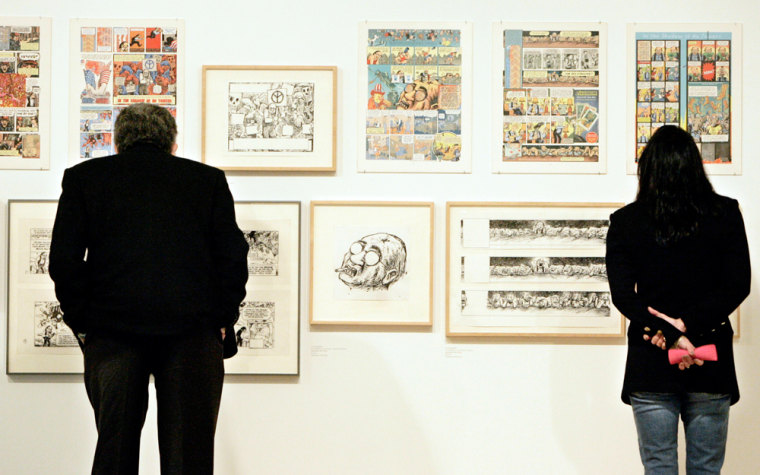The 1990 exhibition was called “High and Low: Modern Art and Popular Culture” and some of the artists from the nation’s funny pages, whose work was represented alongside that of Pablo Picasso and Marcel Duchamp, weren’t amused.
“High and low. You can imagine where comics fell in that spectrum,” chuckles comic strip artist Brian Walker, who can laugh about it 16 years later. He’s laughing because the funny pages are now being taken seriously in a sprawling, yearlong exhibition titled “Masters of American Comics.”
The show opened simultaneously late last year at two major Los Angeles museums, the Hammer and the Museum of Contemporary Art.
After remaining on view through most of this month, it heads to the Milwaukee Art Museum for the spring and summer. After that, it continues east again, opening simultaneously in the fall at The Jewish Museum in New York and the Newark Museum in New Jersey.
Walker, who with art critic John Carlin is co-curator, hopes the collection of 900 works by 15 artists finally gives the funny pages their due.
“It’s done with respect to comics as an art form and not just some kind of footnote to pop art or something like that,” says the “Beetle Bailey” and “Hi and Lois” artist, who is the author of several books on comic strip history.
As such, the sprawling exhibition attempts to track the development of comics as an art form beginning in the first decade of the 20th century and continuing to the present time.
From Little Nemo to Linus, and beyondProgressing in more or less chronological order, it opens with the works of Winsor McCay, who created the comic strip “Little Nemo in Slumberland” in 1905.
“McCay was hailed during his lifetime as America’s greatest cartoonist,” notes Cynthia Burlingham, deputy director of collections at the Hammer, whose staff worked for years with Walker and Carlin in putting the exhibition together.
It progresses from there to Lyonel Feininger, a founding member of the Bauhaus who worked as a cartoonist for less than a year before switching to a celebrated career as an expressionist painter.
Also included are George Herriman, whose more modernist style gave the world the popular Krazy Kat, and Chester Gould, who brought to life the square-jawed, no-nonsense detective Dick Tracy.
Beginning in the 1930s, Gould’s graphic drawing style, coupled with his tales of murder and mayhem, introduced comic strip readers to the darkest comic world they had ever seen. In one panel on display, for example, the villains have left Tracy tied up under a melting block of ice with a stake impaled just above his heart.
The exhibition’s first half then seemingly ends on a lighter note, with an extensive display of works by “Peanuts” creator Charles Schulz. Don’t be fooled, advises Walker.
Although Schulz, who died in 2000, is revered for giving the world Snoopy, the all-knowing beagle that he based on his own pet dog, Spike, he also drew from his childhood experiences to create one of pop culture’s truly heart-wrenching figures.
“Charlie Brown is almost a tragic figure,” Walker says of the hapless 10-year-old who trudges through life waiting for the Little Red-Haired Girl to reject him, rival baseball teams to defeat him, trees to take away his kites and Lucy Van Pelt to pull a football out from under him.
Because of him, Walker says, Schulz is likely to be regarded alongside Mark Twain someday as one of America’s most brilliant social commentators.
“Only his work,” Walker adds, “will be accepted as both literature and art.”
With “good old Charlie Brown” providing a hint of the darkness to come, the exhibit then moves on to the work of such modern “underground” artists as R. Crumb, Art Spiegelman, Jack Kirby, Gary Panter and Chris Ware.
Leaving Snoopy behind, visitors are confronted with Spiegelman’s grim “Maus” strips that portray Jews as mice and Nazis as cats during the Holocaust. The strips won the artist a Pulitzer Prize in 1992, not long after his work was included in the controversial “High and Low” exhibition at New York’s Museum of Modern Art.
More recently, Spiegelman gained acclaim for his “Trade Towers” strips, which mourned the terrorist attacks of Sept. 11, 2001.
Also well represented is Crumb, whose “Zap Comix,” “Fritz the Cat” and other works are credited with helping bring underground comic strips to mainstream attention.
One artist who stands out for not being included is Garry Trudeau. Organizers acknowledge that leaving out the highly political “Doonesbury” creator has generated some controversy of its own.
The idea, Walker says, was to include in the second half of the exhibition contemporary artists whose work is believed to have pushed the boundaries of the art form the farthest. Those like Trudeau, who work in the mainstream medium of newspapers, were not believed to have done that, he said.
Then he quickly adds: “I don’t totally agree with that. I think there are newspaper comic artists like Garry Trudeau who have done some things that had never been done before, and who are very influential.”
But now that the comics are finally getting the respect they deserve, he says, perhaps there will be more exhibitions that will include other artists.
“One of the things that we’ve said repeatedly is that hopefully this is the beginning of a whole new wave,” Walker says.
